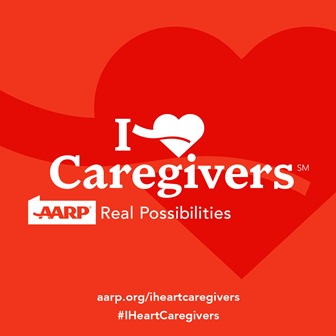AARP Hearing Center

An excerpt from Joanne’s story: “After my Dad died in 1993, I became the primary caregiver for my mom, Anna. And, when mom’s health declined… leading to a series of hospitalizations and rehabilitation stays, my role evolved. I was the point person coordinating Mom’s medication, hospital and health care visits – and making sure mom had homemade Italian meals every day…”
Joanne is one of more than 486,000 Connecticut family caregivers who performs a great labor of love: caring for aging parents, spouses, and other loved ones so they can remain in their homes. These family caregivers are sometimes on duty 24 hours a day, seven days a week – and often they can’t even take a break. But they wouldn’t have it any other way.
That’s why we honor these unsung heroes for their labor of love during November: National Family Caregivers Month.
It’s a fact: the vast majority of older adults want to live independently, at home, as they age. And, family caregivers are the ones who provide the bulk of assistance to make this goal a reality for many. They help with:
• bathing and dressing
• meal preparation
• managing finances
• transportation
• grocery shopping, and much more.
Like Joanne, many family caregivers also perform medical or nursing tasks for their loved ones – like complex medication management, wound care, and injections. Yet, most receive little or no training for these duties.
That’s why AARP Connecticut will be fighting for a commonsense solution called the Caregiver, Advise, Record, Enable (CARE) Act during the upcoming 2015 state legislative session. The CARE Act helps family caregivers when their loved ones go into the hospital and as they transition home. The bill features three important provisions:
• The name of the family caregiver is recorded when a loved one is admitted into a hospital;
• The family caregiver is notified if the loved one is to be discharged to another facility or back home; and,
• The facility must provide an explanation and live instruction of the medical tasks – such as medication management, injections, wound care, and transfers – that the family caregiver will perform at home.
Want to know more about The CARE Act? WATCH THIS VIDEO
Today, the average family caregiver in Connecticut is a 50-year-old female, who takes care of an elderly family member – usually her mother. She provides 20 hours a week of assistance to her loved one, although she may be on call around-the-clock. She is also still likely to be working.
In Connecticut, these family caregivers provide unpaid care valued at an estimated $5.8 billion annually. For our state, their contribution runs even deeper. By helping their older loved ones remain at home – and out of costly nursing homes, usually paid for by Medicaid – family caregivers are, in essence, saving the state money.
But, family caregivers could use some support – so they have the strength and energy to carry on: help at home, workplace protections, training and more. That’s why AARP is fighting for commonsense solutions, like The CARE Act, caregiver employee leave, “respite care” so caregivers can take a hard-earned break¸ and making sure caregivers have the right resources in the community – like home care and adult day care.
Keep in mind: If you’re not a caregiver now, you were one in the past, or you will likely be one in the future. This month, let’s all take a moment to recognize our fellow family caregivers – share your story at aarp.org/iheartcaregivers.































































